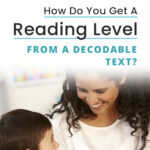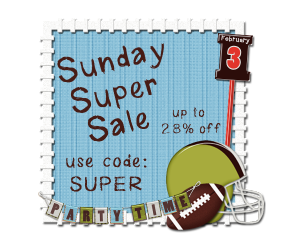If you are teaching a child or group of children how to read, you’re going to want to use decodable books! They are a highly useful tool for teaching kids how to decode, or sound out, words. In this post, I’ll explain what decodable books are, give 6 tips to use them effectively (according to the research), and share where you can find the best decodable books.
The decodable text examples you’ll see throughout this post can be found here:
- Core decodable text sets for Kindergarten, 1st grade, and 2nd grade
- “Decodable Safari” nonfiction decodables for Kindergarten, 1st grade, and 2nd grade
- Seasonal and holiday decodable sets for Kindergarten, 1st grade, and 2nd grade
What Are Decodable Books?
Decodable books are texts that are written especially for young readers who don’t yet have a complete grasp of all phonics patterns or phonics rules. They are “learn to read” tools that give beginning readers practice with decoding words. They provide an opportunity for students to apply their growing phonics knowledge to real reading.
Many decodable texts will focus on a specific phonics skill (for example, short a or l-blends), while others will review a group of phonics skills (for example, long vowels). You will choose decodable texts for kids to read based on what phonics skills they have already learned or are working on.
Decodable readers usually do not include many unknown words that students would not yet be able to sound out. Decodable books usually also include common high-frequency words (you may know them as “sight words”) like “a,” “the,” “and,” “what,” etc.
Decodable books are sometimes also called “decodable readers,” “decodable texts,” or “phonics readers.” The Science of Reading (reading research) supports the use of decodable texts as students learn to read.
Here is an example of a decodable book written to focus on silent e-long vowel words. Notice the words “dunes,” “safe,” “stride,” and “ride” that follow this pattern. The other words on this page (and throughout the text) are words that students A) have already been taught or B) should know how to decode because they follow phonics patterns that students have already learned.
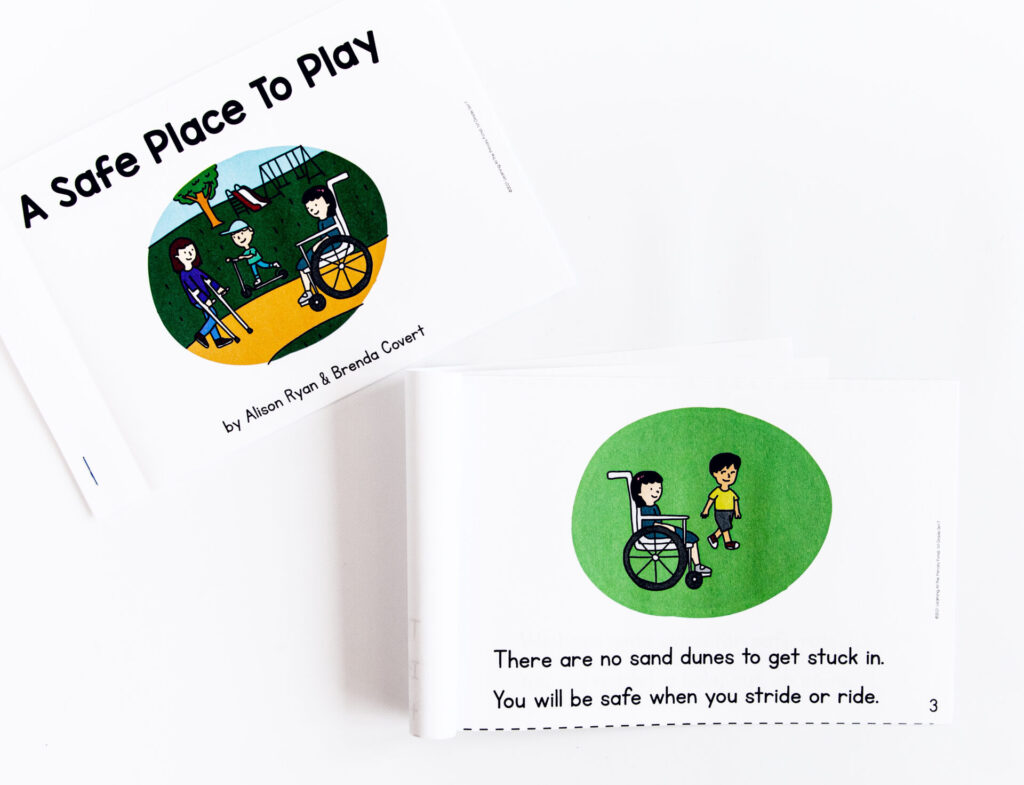
This book comes from these decodable text sets.
Here is an example of a decodable passage that includes multiple vowel teams. Notice the vowel team words “sleeps,” “trees,” “eat,” “flee,” “fight,” “stay,” “lays,” etc. (The underlined words are ones that the teacher pre-teaches before kids read – more on this later.)
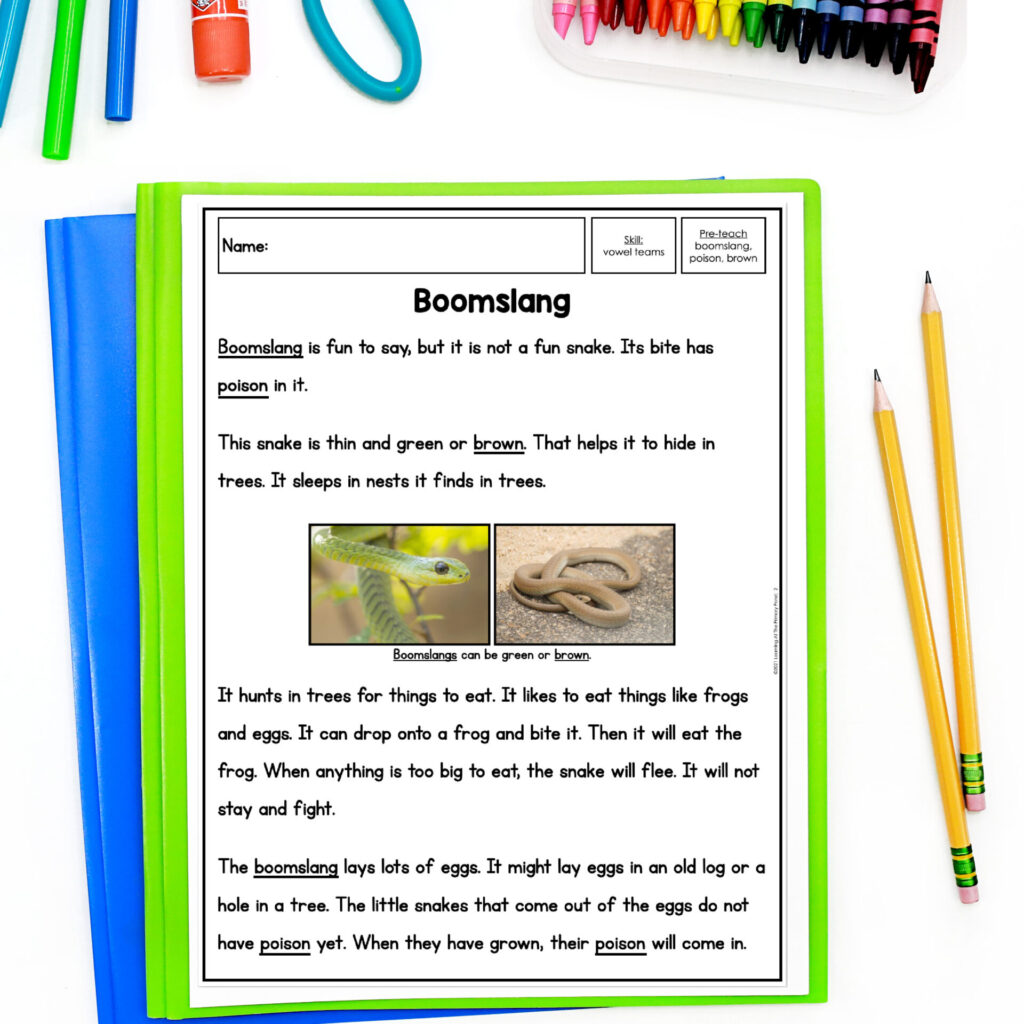
This text comes from this set of decodable passages – they are “Decodable Safari” decodable passages about animals that K-2 kids love!
In addition to everything we’ve discussed so far, decodable texts are also beneficial because they give students an opportunity to review previously-taught phonics skills.
For example, let’s say your students are working on long vowels. When you choose decodable books for them, include books that have both long vowels AND short vowels. This gives them an opportunity to review short vowels and practice choosing the correct vowel sound (between short and long) when reading.
Something else that’s important to know is that decodable texts are helpful for a range of kids who are learning to read, not just a beginning reader who is working on CVC words. They are useful for kids who are working on more challenging skills like multisyllabic words, too!
As kids become more proficient readers, it gets easier to use non-decodable texts (or leveled texts). Their phonics knowledge has grown, so they can be more successful with decoding a wide range of words.
How Can I Best Use Decodable Books to Help Kids Become Strong Readers?
Decodable books are a great tool to support early readers’ development. But it’s important to know how to use decodable books effectively. Here are 6 tips for success:
1. Get clear on what phonics skills your students know and do not know yet.
Assuming you have a phonics scope and sequence (which you should – grab one for free here if you don’t), you will know which skills you’ve taught and have not taught yet. This is a good place to start, but if you teach 1st grade or higher, you’ll also want to make sure that kids truly mastered the skills taught in previous grades.
You can download my free phonics diagnostic assessment here to ensure that you know which phonics skills your kids have mastered and which skills they have not mastered yet.
2. Read every book before using it with your students.
The purpose of using decodable texts is to give kids decoding practice. But if students can’t decode lots of words in a text because they haven’t mastered those phonics skills yet, this defeats the purpose of using a decodable text!
Here’s an analogy. Let’s say you’re coaching a kids’ soccer team. You teach the kids how to dribble the ball down the field. You teach them how to kick to try and score a goal. But you don’t teach them how to pass the ball to each other. Then, you throw them into a soccer game and tell them, “Make sure to pass the ball to each other!”
Your little players aren’t going to know how to do that! They don’t have the necessary skills to be successful in passing and playing the game.
This is exactly what you’re doing if you constantly give kids books with words that they can’t yet decode. You’re not giving them the tools they need to be successful, so they’re going to be forced to guess. They might even become frustrated and give up.
Now, it is TOTALLY okay for a child to read a book and encounter words that they can’t read yet. They may check out a book from the school library and try to read it, even if there are non-decodable words in it. This is absolutely not the end of the world!
But when you are creating intentional opportunities for students to practice reading (i.e. in small group), you want to give them books that they can, for the most part, decode.
That brings me back to my original point – read the book before you use it with students! Even if a book is labeled “decodable,” it could potentially contain phonics concepts that your kids haven’t mastered. When you read the book ahead of time, you’ll know if it’s a good fit for your students.
If there are a couple of words that they may not know or be able to decode yet, you can pre-teach those words – no big deal. (See the photo below for an example of underlined words that a teacher would pre-teach.)
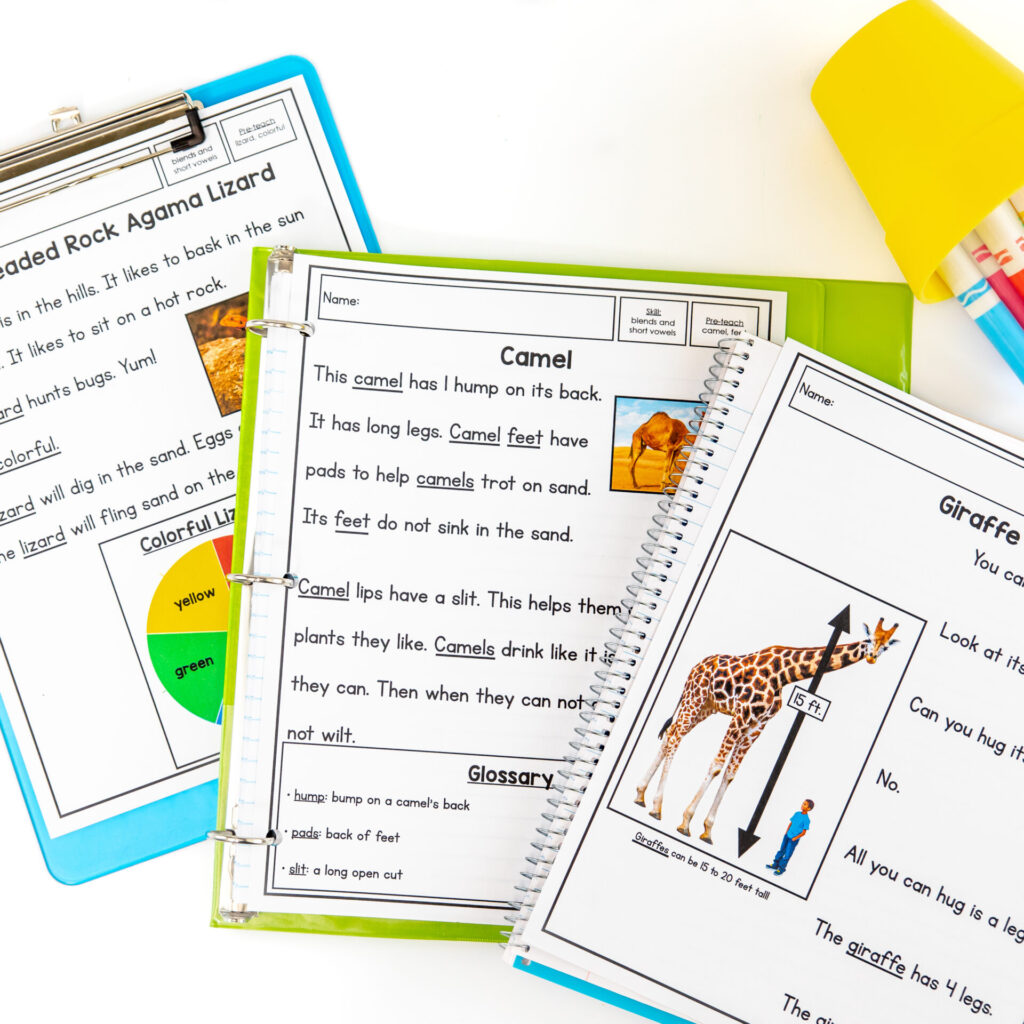
Now, if there are more than just a couple of words that students likely won’t know how to read, then it’s time to choose another book.
3. If you’re working with emergent readers, expect that it will take them a bit of time to get through a decodable book.
When kids are first learning to read, they will decode slowly. This is normal! So if your students do not sound fluent at all, don’t worry. Know that they are going to move through texts slowly at first.
To help with this, you might have them read just a third or a half of a decodable book in one sitting. They can finish the book the next time they meet with you.
Over time, of course, your students’ fluency should improve. This brings me to our next tip…
4. Have kids read a decodable book more than once.
Reading a text more than once helps build fluency. It also helps grow kids’ confidence, because they see themselves getting better at reading. This is especially important if the book is a little (or a lot) hard for them the first time. When they reread, it becomes easier, and they see their own progress!
Rereading has also been shown to improve students’ fluency. They are exposed to the same words multiple times, which is important because it helps them learn to read those words instantly, by sight. Lots of repetition is necessary in learning to read!
If your students get a little tired of rereading a text more than once, try these tips:
- Have them reread to a partner or stuffed animal
- Let them record their reading, read again, and record again – they can watch or listen to both recordings to see how their reading improved
5. Discuss the meaning of the text with students.
Yes, decodable books are designed for decoding practice. But we also need to help students make meaning from the text! Ask your students to retell every decodable text they read. You can also ask them comprehension questions to encourage them to think more deeply about the text.
If we don’t do any comprehension work with decodable books, kids are going to start to think that the whole point of reading is to sound out the words. In reality, however, the whole point of sounding out the words is to understand what the text is saying! So we need to communicate, from the very start, that the purpose of reading is to comprehend text. Otherwise, our older students are going to continue that habit of reading to say the words – not reading to comprehend.
Are decodable texts going to have the same level of rich content and vocabulary as children’s literature? No, they aren’t. And that’s okay! Continue reading aloud and discussing books with your students during a separate time of the day.
There are tons of fun activities you can do to work on comprehension with decodable texts, too! The photo below shows an example from my 4-seasons decodable texts (in this case, the fall set). In addition to the decodable passage, you also get questions for the kids to answer (back left) and a sequence of events graphic organizer (front).
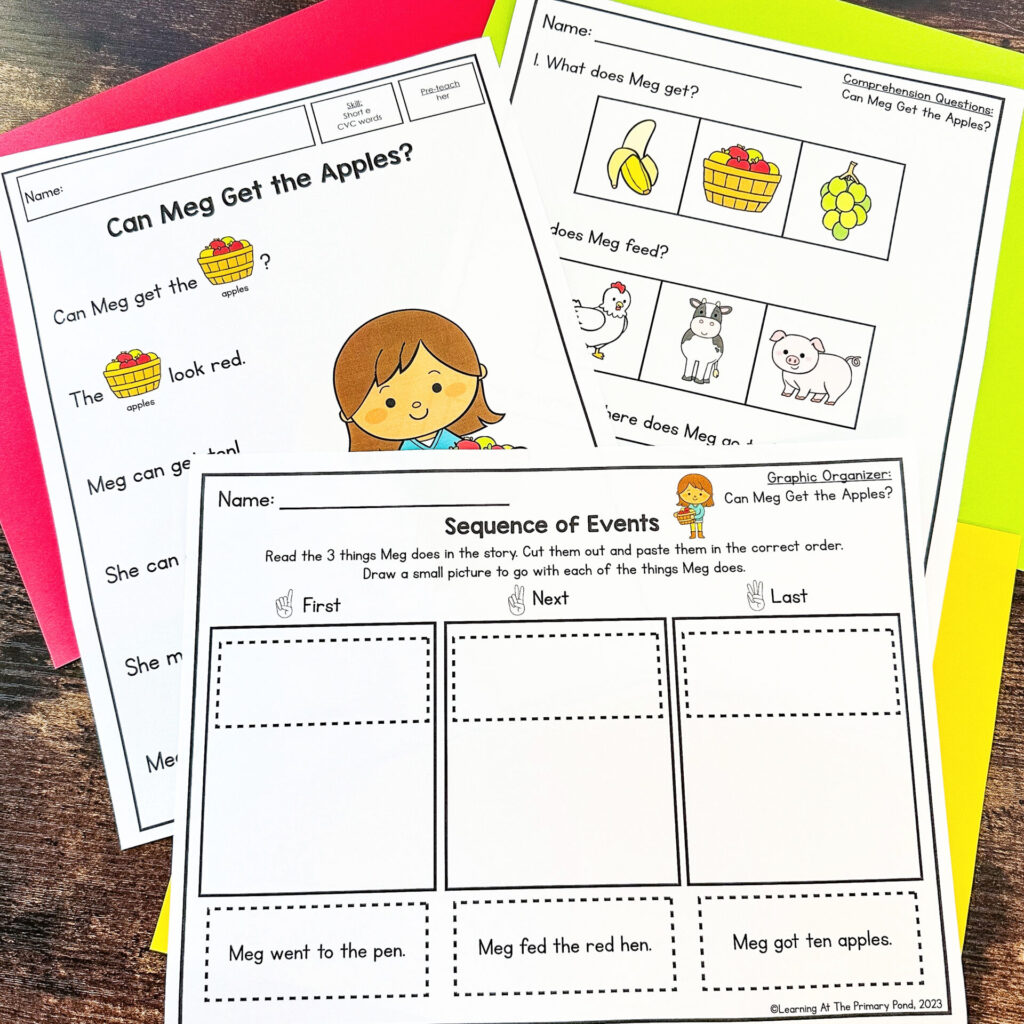
You can grab my 4-seasons decodable sets at this link! Every passage includes a question set and graphic organizer like the one shown here.
6. Have students write about decodable texts.
Having kids write about the decodable texts they read serves two purposes. First, it can help deepen their comprehension and thinking about the text in order to answer questions about it. Second, it gets them using the decodable words included in the text – which reinforces phonics skills and spelling! You might have kids read a decodable text in small group and then have them write about the text as a follow-up independent activity.
In the photo below, you’ll notice how our decodable passages (for 2nd grade in this case), include a question for students to respond to after they read (bottom of each page).
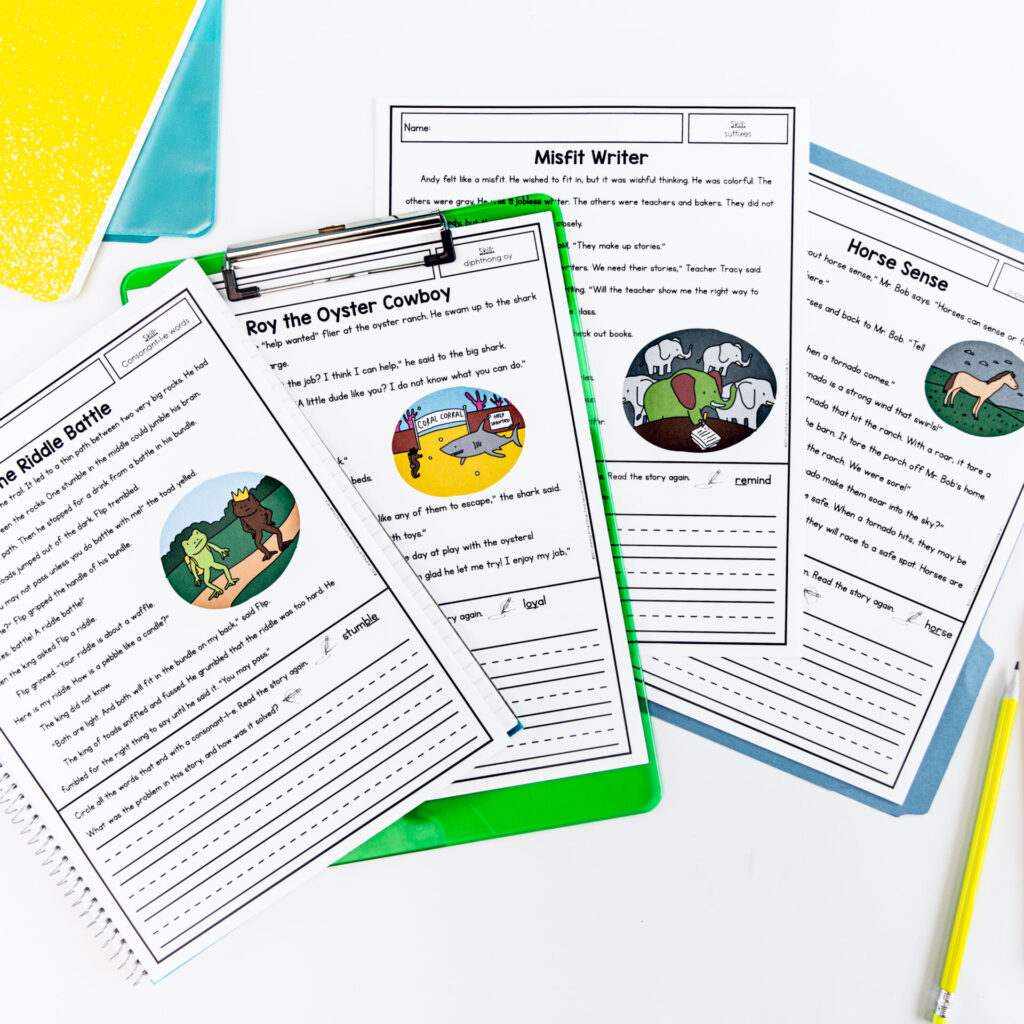
You can grab these decodable sets for Kindergarten, 1st grade, or 2nd grade here!
Where Can I Find the Best Decodable Books?
Honestly, the best decodable readers are the ones that match your phonics scope and sequence! As I shared in the tips above, the main point of using decodable texts is so that kids can practice what they have been taught.
Sometimes it can be tricky to find decodable readers that are a precise match for your scope and sequence. Just know that it’s totally okay if there are 1-4 words (the fewer the better for beginning readers) that you have to pre-teach kids before they read a text. While you want to look for alignment with your scope and sequence, you can still use books that aren’t a perfect 100% match.
You’ll also want to look for decodable texts that are:
- Well-written and sound relatively “normal” (of course, decodable books are not going to sound as natural as “typical” children’s literature – but you still want the texts to be understandable by kids)
- Engaging for young readers
- Provide at least some content to discuss, so kids can make meaning from them and practice basic comprehension skills
Below are links to sets of decodable books and passages that we have available. They are printable, which means you can access them instantly. And one advantage of using printable books is that kids can write on them! They can circle words with a target phonics pattern, underline high-frequency words, etc.
- Core decodable text sets for Kindergarten, 1st grade, and 2nd grade
- “Decodable Safari” nonfiction decodables for Kindergarten, 1st grade, and 2nd grade
- Seasonal and holiday decodable sets for Kindergarten, 1st grade, and 2nd grade
Other great “hard copy” options include the Flyleaf books and Whole Phonics books. Many parents and teachers also like the BOB Books.
Save This For Later!
There was a lot of information in this post, so you may want to save it for later! You can grab this image and pin it to your favorite Pinterest board so you can come back to it in the future.
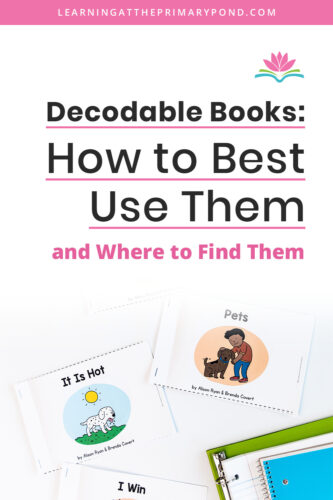
Happy teaching!



